Production and Characterization of Recombinant Wild Type Uricase from Indonesian Coelacanth (L. menadoensis) and Improvement of Its Thermostability by In Silico Rational Design and Disulphide Bridges Engineering
Abstract
1. Introduction
2. Results
2.1. Multiple Sequence Alignment (MSA) and Phylogenetic Analysis
2.2. Homology Modeling and Quality Evaluation of the Predicted Models
2.3. Prediction of Potential Disulfide Bridges
2.4. Protein Expression and Purification
2.5. Enzymatic Activity and Kinetic Parameters
2.6. Characterization of WT LM-UOX and Mutants
2.7. Stability of WT LM-UOX and Mutants
3. Discussion
4. Materials and Methods
4.1. Bacterial Strains, Plasmid and Chemicals
4.2. Multiple Sequence Alignment (MSA) and Phylogenetic Analysis
4.3. Homology Modelling
4.4. Prediction of Potential Disulfide Bridges
4.5. DNA Manipulations
4.6. Protein Expression and Purification
4.7. Polyacrylamide Gel Electrophoresis
4.8. Uricase Activity Assay
4.9. Enzyme Characterization
4.10. Thermostability Measurement
4.11. Circular Dichroism Spectroscopy
5. Conclusions
Author Contributions
Funding
Acknowledgments
Conflicts of Interest
References
- Colloc’h, N.; Hajji, M.E.; Bachet, B.; L’Hermite, G.; Schiltz, M.; Prangé, T.; Castro, B.; Mornon, J.-P. Crystal Structure of the protein drug urate oxidase-inhibitor complex at 2.05 Å resolution. Nat. Struct. Mol. Biol. 1997, 4, 947–952. [Google Scholar] [CrossRef]
- Ramazzina, I.; Folli, C.; Secchi, A.; Berni, R.; Percudani, R. Completing the uric acid degradation pathway through phylogenetic comparison of whole genomes. Nat. Chem. Biol. 2006, 2, 144–148. [Google Scholar] [CrossRef] [PubMed]
- Varela-Echavarría, A.; Montes de Oca-Luna, R.; Barrera-Saldaña, H.A. Uricase protein sequences: Conserved during vertebrate evolution but absent in humans. FASEB J. 1988, 2, 3092–3096. [Google Scholar] [CrossRef] [PubMed]
- Oda, M.; Satta, Y.; Takenaka, O.; Takahata, N. Loss of urate oxidase activity in hominoids and its evolutionary implications. Mol. Biol. Evol. 2002, 19, 640–653. [Google Scholar] [CrossRef] [PubMed]
- Neogi, T. Clinical practice. Gout. N. Engl. J. Med. 2011, 364, 443–452. [Google Scholar] [CrossRef] [PubMed]
- Feig, D.I.; Kang, D.-H.; Johnson, R.J. Uric acid and cardiovascular risk. N. Engl. J. Med. 2008, 359, 1811–1821. [Google Scholar] [CrossRef]
- Stamp, L.K.; Chapman, P.T. Urate-lowering therapy: Current options and future prospects for elderly patients with gout. Drugs Aging 2014, 31, 777–786. [Google Scholar] [CrossRef] [PubMed]
- Ramasamy, S.N.; Korb-Wells, C.S.; Kannangara, D.R.W.; Smith, M.W.H.; Wang, N.; Roberts, D.M.; Graham, G.G.; Williams, K.M.; Day, R.O. Allopurinol hypersensitivity: A systematic review of all published cases, 1950–2012. Drug Saf. 2013, 36, 953–980. [Google Scholar] [CrossRef]
- Fels, E.; Sundy, J.S. Refractory gout: What is it and what to do about it? Curr. Opin. Rheumatol. 2008, 20, 198–202. [Google Scholar] [CrossRef]
- Howard, S.C.; Jones, D.P.; Pui, C.-H. The tumor lysis syndrome. N. Engl. J. Med. 2011, 364, 1844–1854. [Google Scholar] [CrossRef]
- Masera, G.; Jankovic, M.; Zurlo, M.G.; Locasciulli, A.; Rossi, M.R.; Uderzo, C.; Recchia, M. Urate-oxidase prophylaxis of uric acid-induced renal damage in childhood leukemia. J. Pediatr. 1982, 100, 152–155. [Google Scholar] [CrossRef]
- Pui, C.H.; Mahmoud, H.H.; Wiley, J.M.; Woods, G.M.; Leverger, G.; Camitta, B.; Hastings, C.; Blaney, S.M.; Relling, M.V.; Reaman, G.H. Recombinant urate oxidase for the prophylaxis or treatment of hyperuricemia in patients with leukemia or lymphoma. J. Clin. Oncol. 2001, 19, 697–704. [Google Scholar] [CrossRef] [PubMed]
- London, M.; Hudson, P.B. Uricolytic activity of purified uricase in two human beings. Science 1957, 125, 937–938. [Google Scholar] [CrossRef] [PubMed]
- Kissel, P.; Lamarche, M.; Royer, R. Modification of uricaemia and the excretion of uric acid nitrogen by an enzyme of fungal origin. Nature 1968, 217, 72–74. [Google Scholar] [CrossRef]
- Coiffier, B.; Mounier, N.; Bologna, S.; Fermé, C.; Tilly, H.; Sonet, A.; Christian, B.; Casasnovas, O.; Jourdan, E.; Belhadj, K.; et al. Efficacy and safety of rasburicase (recombinant urate oxidase) for the prevention and treatment of hyperuricemia during induction chemotherapy of aggressive non-Hodgkin’s lymphoma: Results of the GRAAL1 (Groupe d’Etude des Lymphomes de l’Adulte Trial on Rasburicase Activity in Adult Lymphoma) study. J. Clin. Oncol. 2003, 21, 4402–4406. [Google Scholar]
- Sundy, J.S.; Baraf, H.S.B.; Yood, R.A.; Edwards, N.L.; Gutierrez-Urena, S.R.; Treadwell, E.L.; Vázquez-Mellado, J.; White, W.B.; Lipsky, P.E.; Horowitz, Z.; et al. Efficacy and tolerability of pegloticase for the treatment of chronic gout in patients refractory to conventional treatment: Two randomized controlled trials. JAMA 2011, 306, 711–720. [Google Scholar] [PubMed]
- Ueng, S. Rasburicase (Elitek): A novel agent for tumor lysis syndrome. In Baylor University Medical Center Proceedings; Taylor & Francis: Abingdon, UK, 2005; Volume 18, pp. 275–279. [Google Scholar]
- Allen, K.C.; Champlain, A.H.; Cotliar, J.A.; Belknap, S.M.; West, D.P.; Mehta, J.; Trifilio, S.M. Risk of anaphylaxis with repeated courses of rasburicase: A Research on Adverse Drug Events and Reports (RADAR) project. Drug Saf. 2015, 38, 183–187. [Google Scholar] [CrossRef]
- Lipsky, P.E.; Calabrese, L.H.; Kavanaugh, A.; Sundy, J.S.; Wright, D.; Wolfson, M.; Becker, M.A. Pegloticase immunogenicity: The relationship between efficacy and antibody development in patients treated for refractory chronic gout. Arthritis Res. Ther. 2014, 16, R60. [Google Scholar] [CrossRef]
- Fan, K.; Zhang, C.; Ma, X.; Mei, X.; Hu, C. Humanized Recombinant Uricase and Mutants Thereof. U.S. Patent 8586535B2, 19 November 2013. [Google Scholar]
- Rong, J.; Kuang, H.; Sun, Z. Preparation and Application Method of PEG Recombinant Pig-Human Urate Oxidase Fusion Protein. China CN102260653B, 30 November 2011. [Google Scholar]
- Forconi, M.; Biscotti, M.A.; Barucca, M.; Buonocore, F.; De Moro, G.; Fausto, A.M.; Gerdol, M.; Pallavicini, A.; Scapigliati, G.; Schartl, M.; et al. Characterization of purine catabolic pathway genes in coelacanths. J. Exp. Zool. B Mol. Dev. Evol. 2014, 322, 334–341. [Google Scholar] [CrossRef]
- Nucleotide BLAST: Search Nucleotide Databases Using a Nucleotide Query. Available online: https://blast.ncbi.nlm.nih.gov/Blast.cgi?PROGRAM=blastp&PAGE_TYPE=BlastSearch&LINK_LOC=blasthome (accessed on 11 February 2019).
- Kratzer, J.T.; Lanaspa, M.A.; Murphy, M.N.; Cicerchi, C.; Graves, C.L.; Tipton, P.A.; Ortlund, E.A.; Johnson, R.J.; Gaucher, E.A. Evolutionary history and metabolic insights of ancient mammalian uricases. Proc. Natl. Acad. Sci. USA 2014, 111, 3763–3768. [Google Scholar] [CrossRef]
- Hruban, Z.; Swift, H. Uricase: Localization in hepatic microbodies. Science 1964, 146, 1316–1318. [Google Scholar] [CrossRef] [PubMed]
- Hayashi, S.; Fujiwara, S.; Noguchi, T. Evolution of urate-degrading enzymes in animal peroxisomes. Cell Biochem. Biophys. 2000, 32, 123–129. [Google Scholar] [CrossRef]
- Usuda, N.; Reddy, M.K.; Hashimoto, T.; Rao, M.S.; Reddy, J.K. Tissue specificity and species differences in the distribution of urate oxidase in peroxisomes. Lab. Investig. 1988, 58, 100–111. [Google Scholar] [PubMed]
- Retailleau, P.; Colloc’h, N.; Vivarès, D.; Bonneté, F.; Castro, B.; El-Hajji, M.; Mornon, J.P.; Monard, G.; Prangé, T. Complexed and ligand-free high-resolution structures of urate oxidase (Uox) from Aspergillus flavus: A reassignment of the active-site binding mode. Acta Crystallogr. D Biol. Crystallogr. 2004, 60, 453–462. [Google Scholar] [CrossRef]
- Robert, X.; Gouet, P. Deciphering key features in protein structures with the new ENDscript server. Nucleic Acids Res. 2014, 42, W320–W324. [Google Scholar] [CrossRef]
- Hudson, P.B.; London, M. Purification and properties of solubilized uricase. Biochim. Biophys. Acta 1956, 21, 290–298. [Google Scholar] [PubMed]
- Laboureur, P.; Langlois, C. [Properties of a fungal urate oxidase with high activity]. C. R. Hebd. Seances Acad. Sci. Ser. D Sci. Nat. 1967, 264, 2244–2246. [Google Scholar]
- Royer, R.; Vindel, J.; Lamarche, M.; Kissel, P. [Modalities of purine excretion during enzyme treatment of gout and other hyperuricemic conditions with urate oxidase]. Presse Med. 1968, 76, 2325–2327. [Google Scholar] [PubMed]
- Caput, D.; Ferrara, P.; Guillemot, J.-C.; Kaghad, M.; Legoux, R.; Loison, G.; Larbre, E.; Lupker, J.; Leplatois, P.; Salome, M.; Laurent, P. Urate Oxidase Activity Protein, Recombinant Gene Coding Therefor, Expression vector, MICRO-Organisms and Transformed Cells. U.S. Patent 5382518A, 17 January 1995. [Google Scholar]
- Deehan, M.; Garcês, S.; Kramer, D.; Baker, M.P.; Rat, D.; Roettger, Y.; Kromminga, A. Managing unwanted immunogenicity of biologicals. Autoimmun. Rev. 2015, 14, 569–574. [Google Scholar] [CrossRef] [PubMed]
- Hershfield, M.; Kelly, S.J. Urate Oxidase. 2006. Available online: https://patents.google.com/patent/US7056713 (accessed on 13 March 2019).
- Smith, J.L.B. A living fish of mesozoic type. Nature 1939, 143, 455–456. [Google Scholar] [CrossRef]
- Zhu, M.; Yu, X.; Lu, J.; Qiao, T.; Zhao, W.; Jia, L. Earliest known coelacanth skull extends the range of anatomically modern coelacanths to the Early Devonian. Nat. Commun. 2012, 3, 772. [Google Scholar] [CrossRef] [PubMed]
- Zimmer, C.; Buell, C.D. At the Water’s Edge: Fish with Fingers, Whales with Legs, and How Life Came Ashore But Then Went Back to Sea; Simon & Schuster Adult Publishing Group: New York, NY, USA, 1999; p. 304. [Google Scholar]
- Ganson, N.J.; Kelly, S.J.; Scarlett, E.; Sundy, J.S.; Hershfield, M.S. Control of hyperuricemia in subjects with refractory gout, and induction of antibody against poly(ethylene glycol) (PEG), in a phase I trial of subcutaneous PEGylated urate oxidase. Arthritis Res. Ther. 2006, 8, R12. [Google Scholar] [CrossRef]
- Tian, H.; Guo, Y.; Gao, X.; Yao, W. PEGylation enhancement of pH stability of uricase via inhibitive tetramer dissociation. J. Pharm. Pharmacol. 2013, 65, 53–63. [Google Scholar] [CrossRef] [PubMed]
- Hibi, T.; Kume, A.; Kawamura, A.; Itoh, T.; Fukada, H.; Nishiya, Y. Hyperstabilization of Tetrameric Bacillus sp. TB-90 Urate Oxidase by Introducing Disulfide Bonds through Structural Plasticity. Biochemistry 2016, 55, 724–732. [Google Scholar] [CrossRef]
- Mueller, C.; Altenburger, U.; Mohl, S. Challenges for the pharmaceutical technical development of protein coformulations. J. Pharm. Pharmacol. 2018, 70, 666–674. [Google Scholar] [CrossRef] [PubMed]
- Li, K.-B. ClustalW-MPI: ClustalW analysis using distributed and parallel computing. Bioinformatics 2003, 19, 1585–1586. [Google Scholar] [CrossRef] [PubMed]
- Saitou, N.; Nei, M. The neighbor-joining method: A new method for reconstructing phylogenetic trees. Mol. Biol. Evol. 1987, 4, 406–425. [Google Scholar] [PubMed]
- Zuckerkandl, E.; Pauling, L. Evolutionary divergence and convergence in proteins. In Evolving Genes And Proteins; Elsevier: Amsterdam, The Netherlands, 1965; pp. 97–166. [Google Scholar]
- Kumar, S.; Stecher, G.; Li, M.; Knyaz, C.; Tamura, K. MEGA X: Molecular Evolutionary Genetics Analysis across Computing Platforms. Mol. Biol. Evol. 2018, 35, 1547–1549. [Google Scholar] [CrossRef]
- Waterhouse, A.; Bertoni, M.; Bienert, S.; Studer, G.; Tauriello, G.; Gumienny, R.; Heer, F.T.; de Beer, T.A.P.; Rempfer, C.; Bordoli, L.; et al. SWISS-MODEL: Homology modelling of protein structures and complexes. Nucleic Acids Res. 2018, 46, W296–W303. [Google Scholar] [CrossRef] [PubMed]
- Marchetti, M.; Liuzzi, A.; Fermi, B.; Corsini, R.; Folli, C.; Speranzini, V.; Gandolfi, F.; Bettati, S.; Ronda, L.; Cendron, L.; et al. Catalysis and Structure of Zebrafish Urate Oxidase Provide Insights into the Origin of Hyperuricemia in Hominoids. Sci. Rep. 2016, 6, 38302. [Google Scholar] [CrossRef] [PubMed]
- Benkert, P.; Biasini, M.; Schwede, T. Toward the estimation of the absolute quality of individual protein structure models. Bioinformatics 2011, 27, 343–350. [Google Scholar] [CrossRef]
- Laskowski, R.A.; MacArthur, M.W.; Moss, D.S.; Thornton, J.M. PROCHECK: A program to check the stereochemical quality of protein structures. J. Appl. Crystallogr. 1993, 26, 283–291. [Google Scholar] [CrossRef]
- Bowie, J.U.; Lüthy, R.; Eisenberg, D. A method to identify protein sequences that fold into a known three-dimensional structure. Science 1991, 253, 164–170. [Google Scholar] [CrossRef]
- Lüthy, R.; Bowie, J.U.; Eisenberg, D. Assessment of protein models with three-dimensional profiles. Nature 1992, 356, 83–85. [Google Scholar] [CrossRef] [PubMed]
- Wiederstein, M.; Sippl, M.J. ProSA-web: Interactive web service for the recognition of errors in three-dimensional structures of proteins. Nucleic Acids Res. 2007, 35, W407–W410. [Google Scholar] [CrossRef]
- Wallner, B.; Elofsson, A. Can correct protein models be identified? Protein Sci. 2003, 12, 1073–1086. [Google Scholar] [CrossRef] [PubMed]
- Schrodinger. PyMOL: The PyMOL Molecular Graphics System, Version 1.8; Schrödinger, LLC: New York, NY, USA, 2019. [Google Scholar]
- Craig, D.B.; Dombkowski, A.A. Disulfide by Design 2.0: A web-based tool for disulfide engineering in proteins. BMC Bioinform. 2013, 14, 346. [Google Scholar] [CrossRef] [PubMed]
- Laemmli, U.K. Cleavage of structural proteins during the assembly of the head of bacteriophage T4. Nature 1970, 227, 680–685. [Google Scholar] [CrossRef]

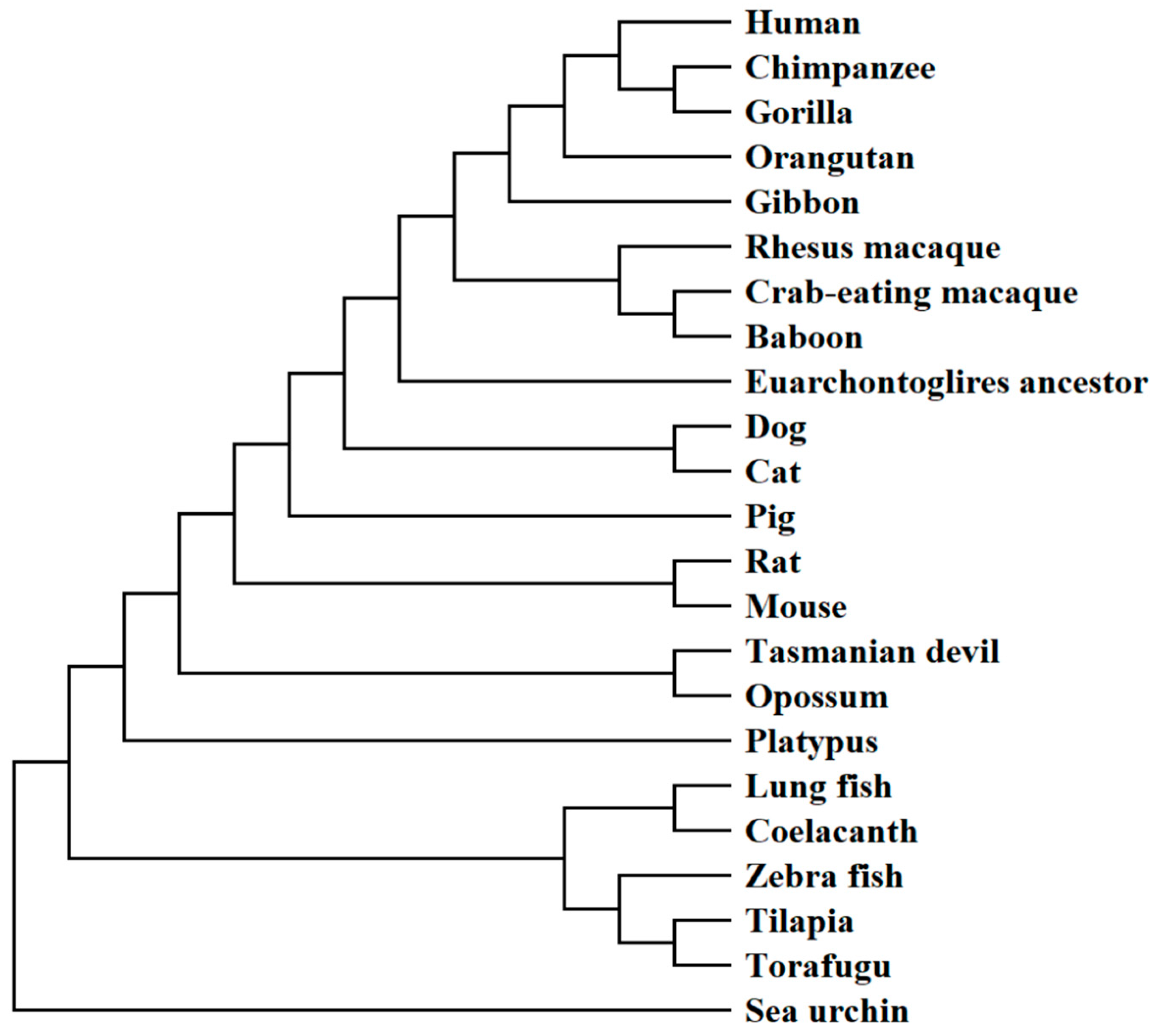

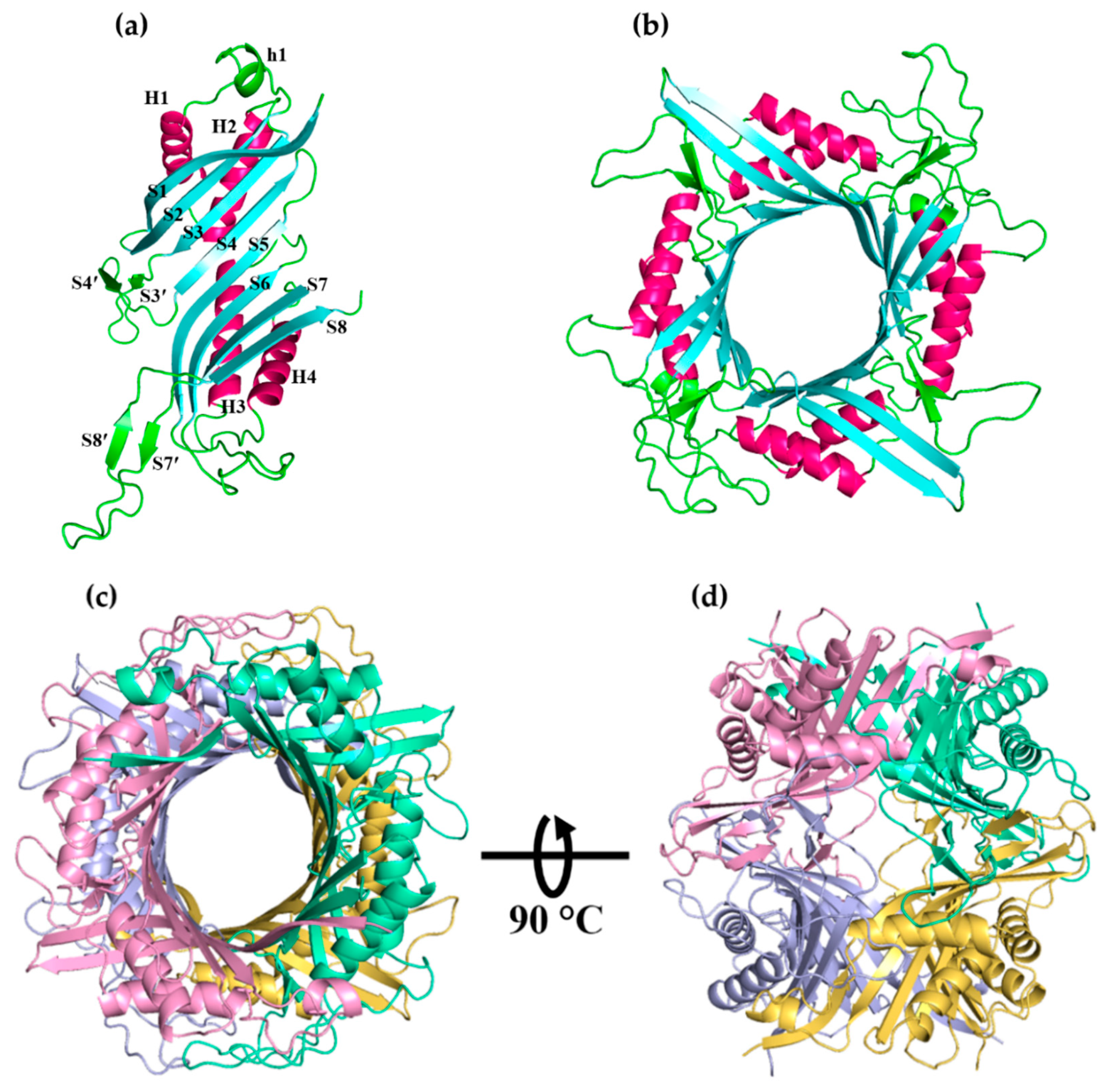
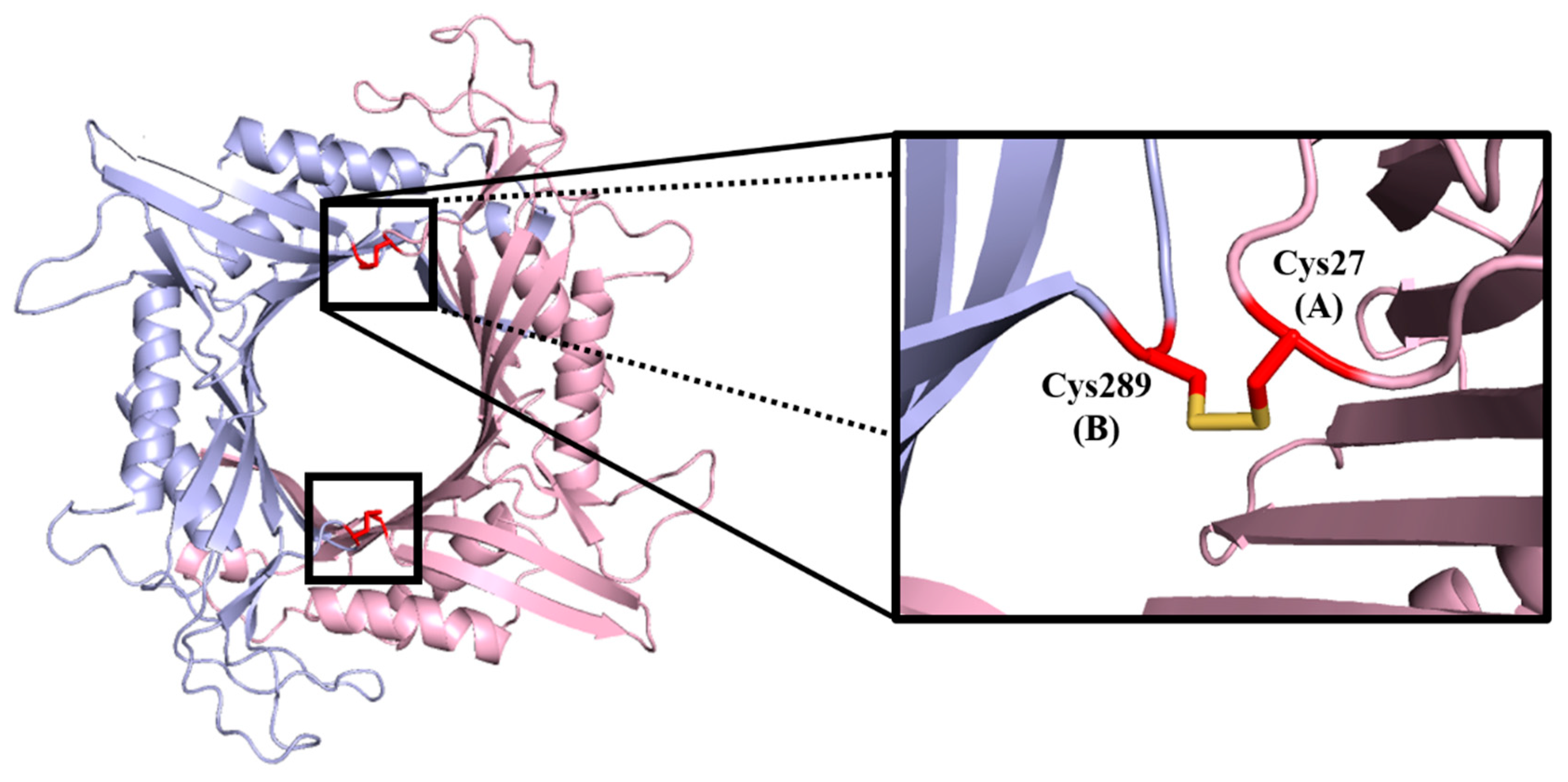
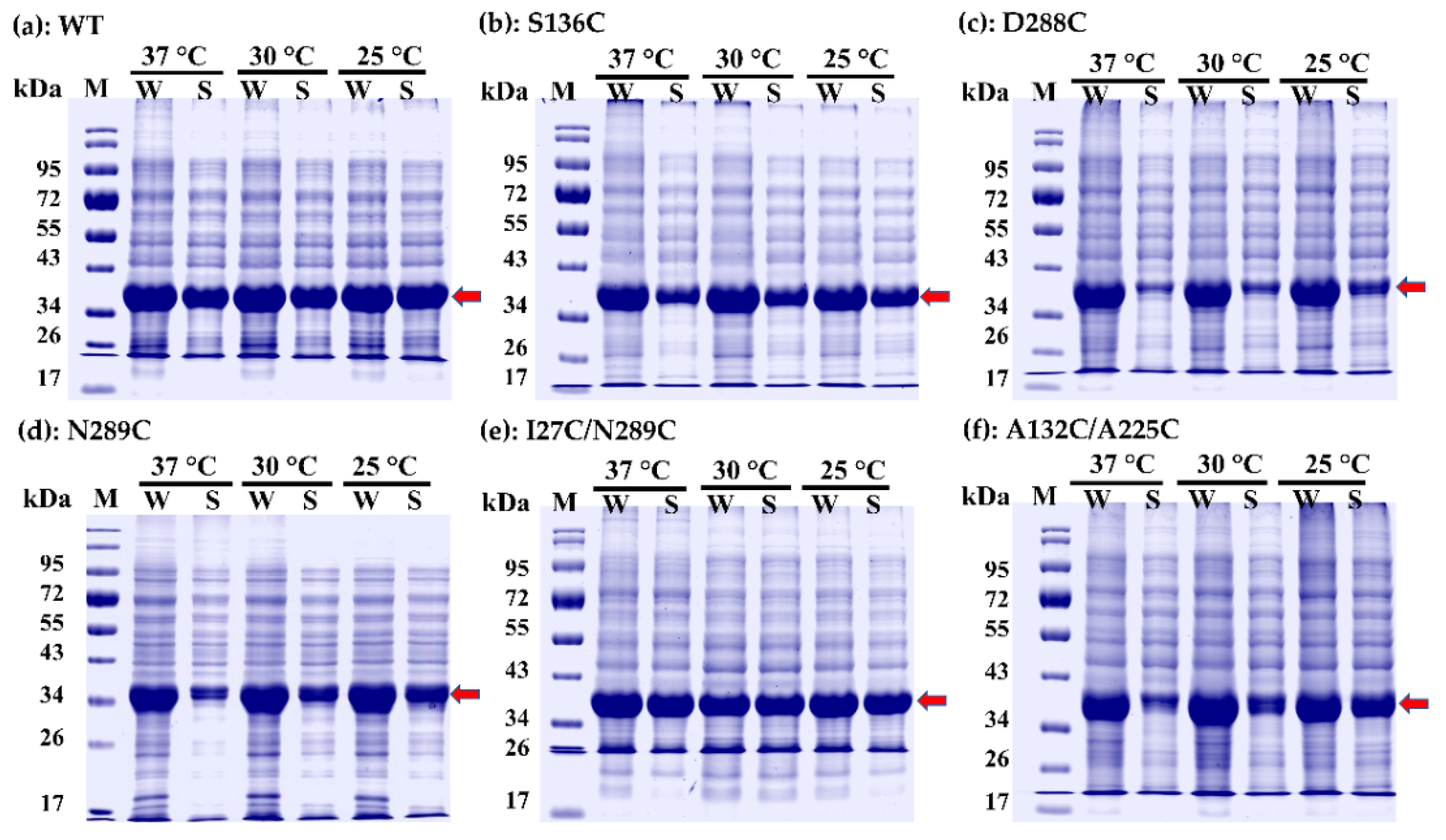
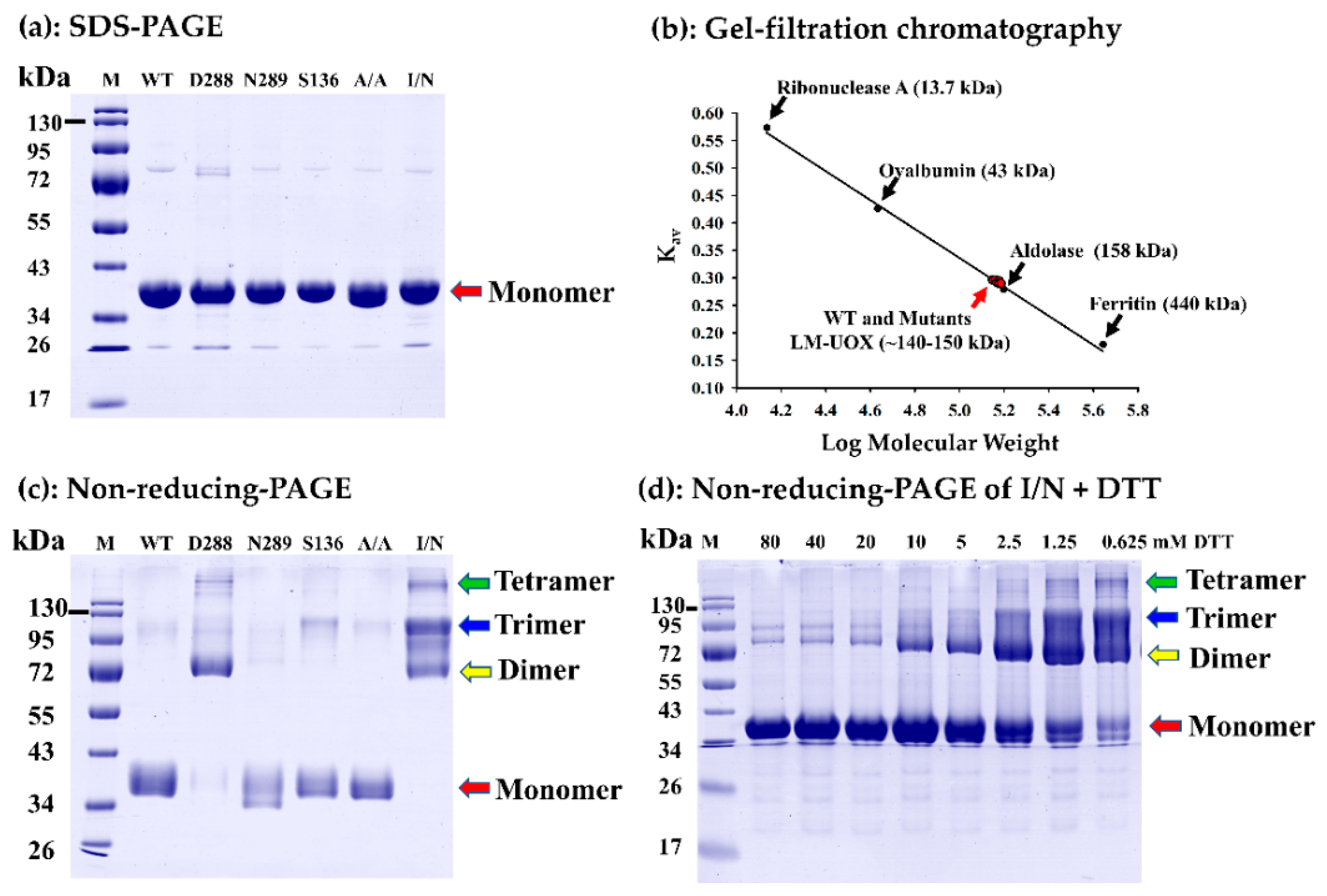
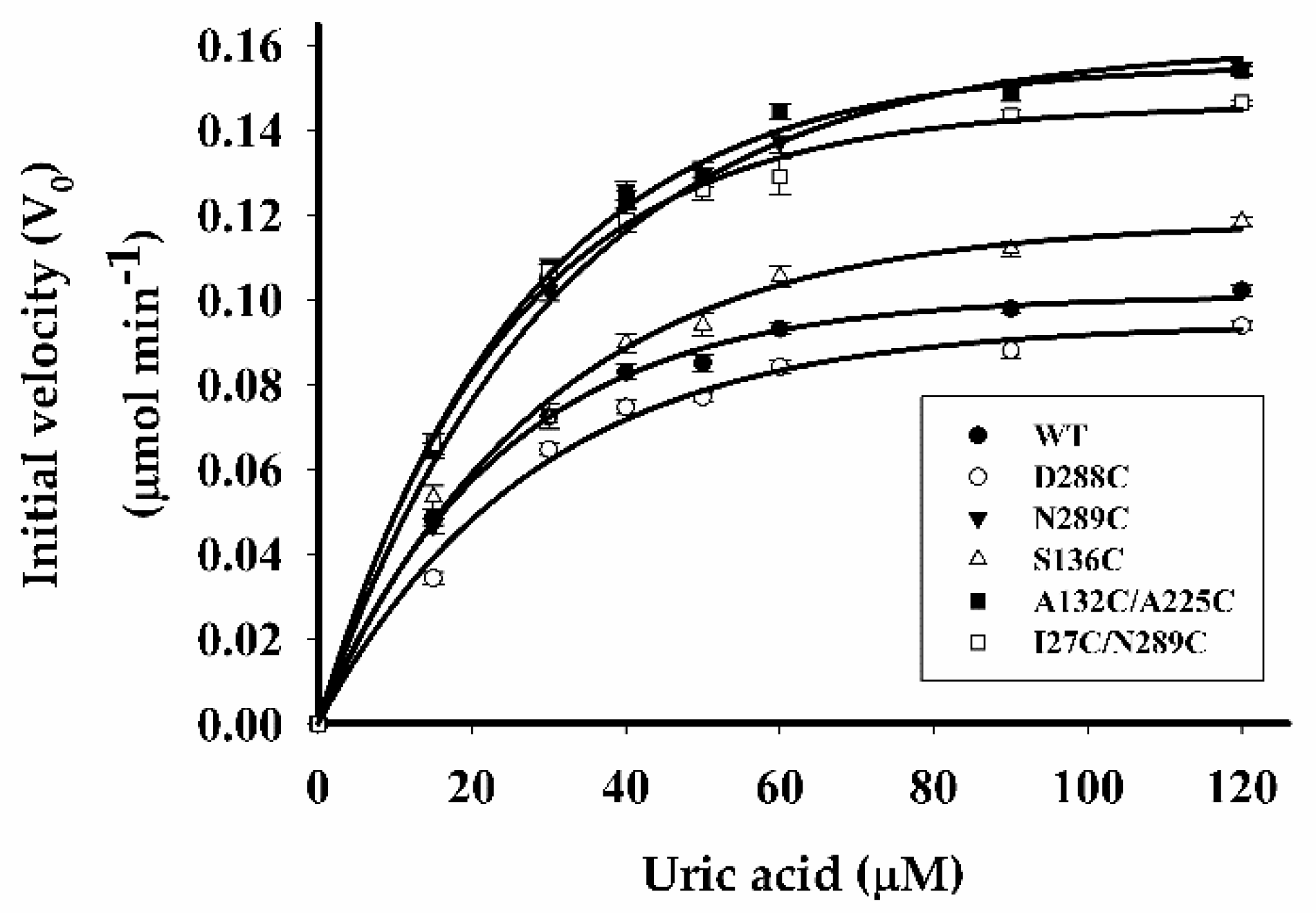
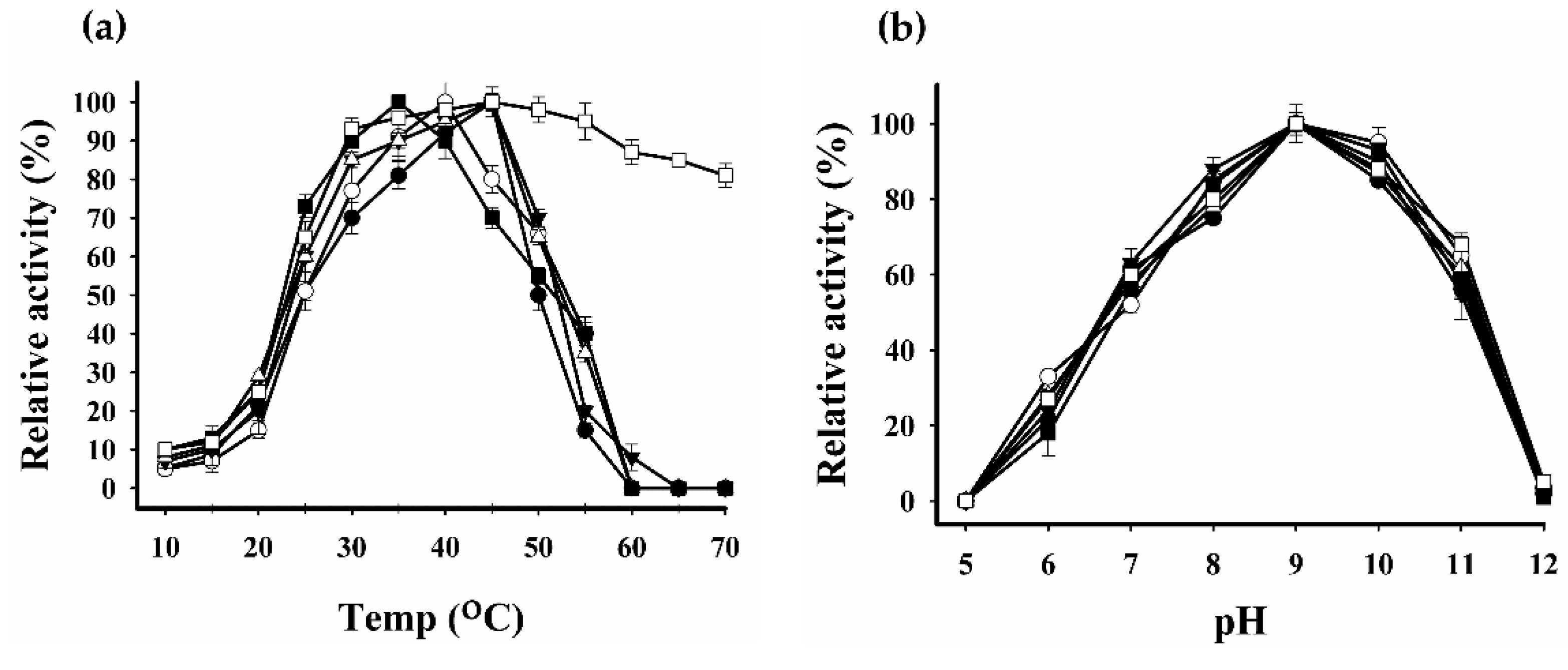
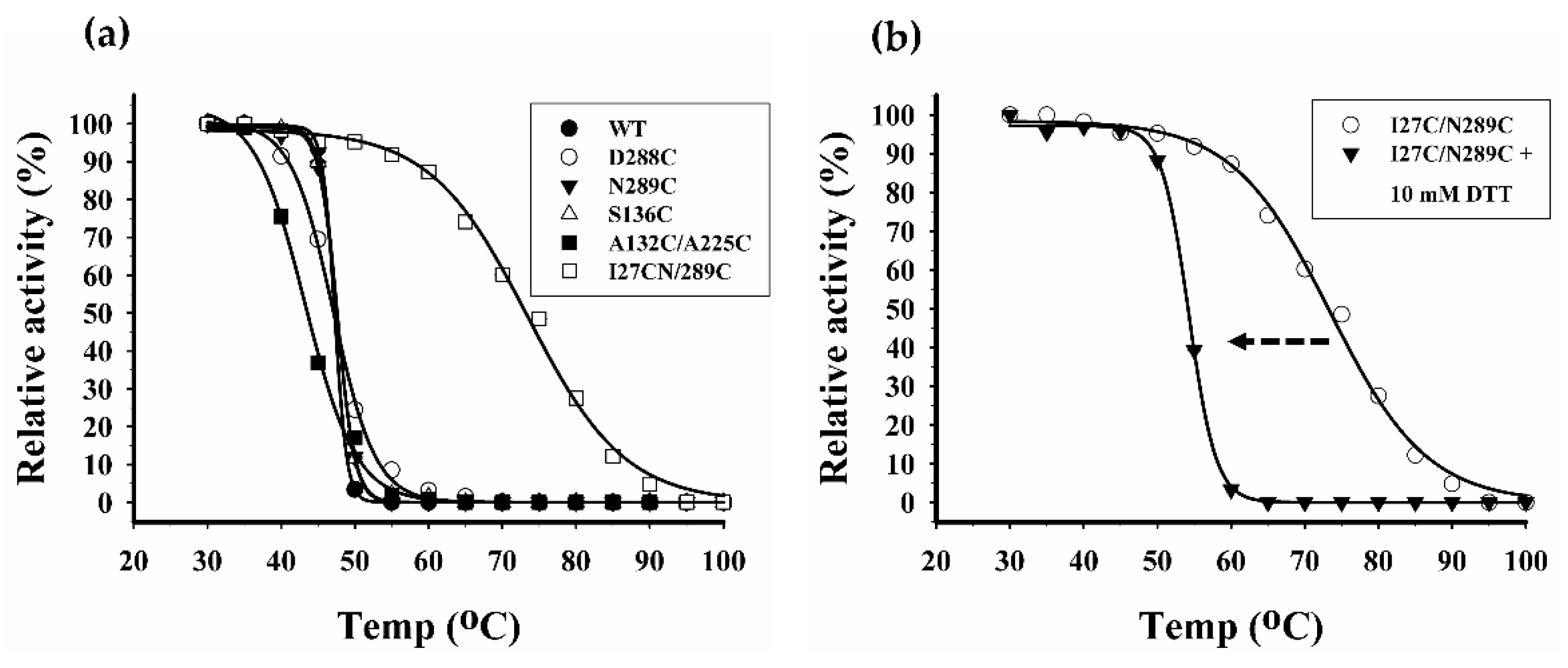
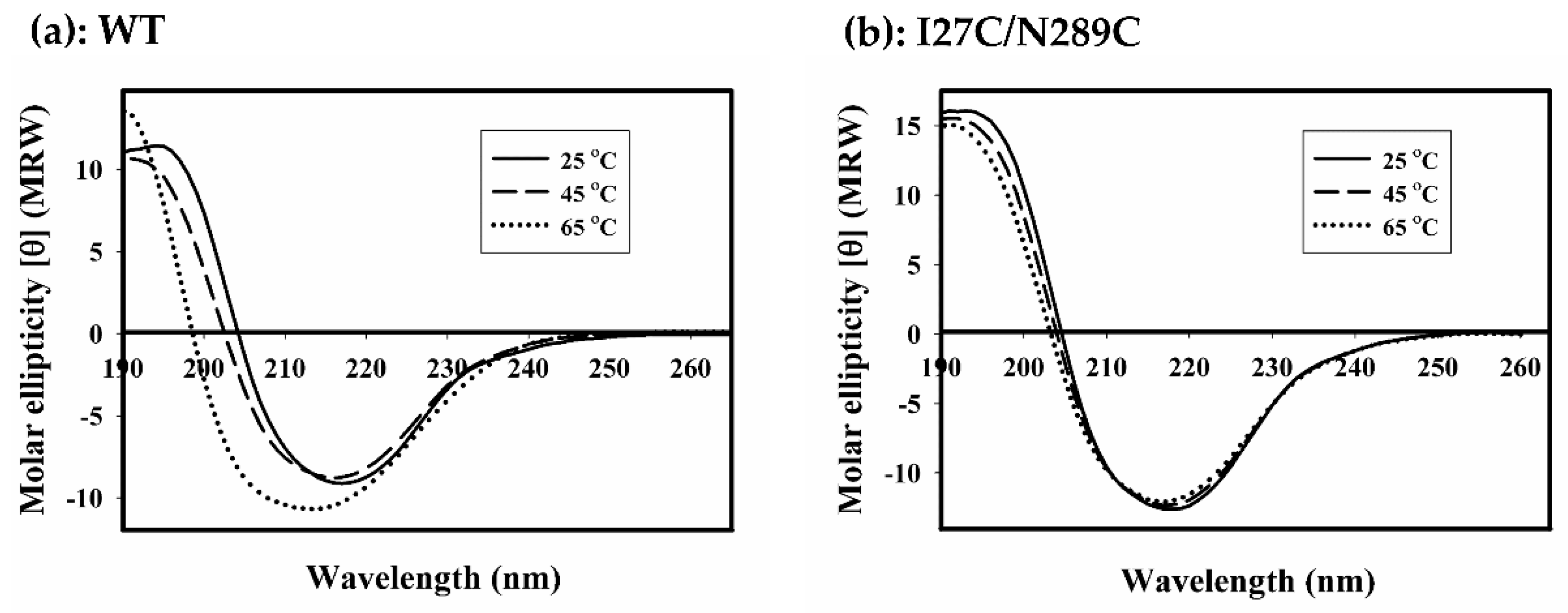
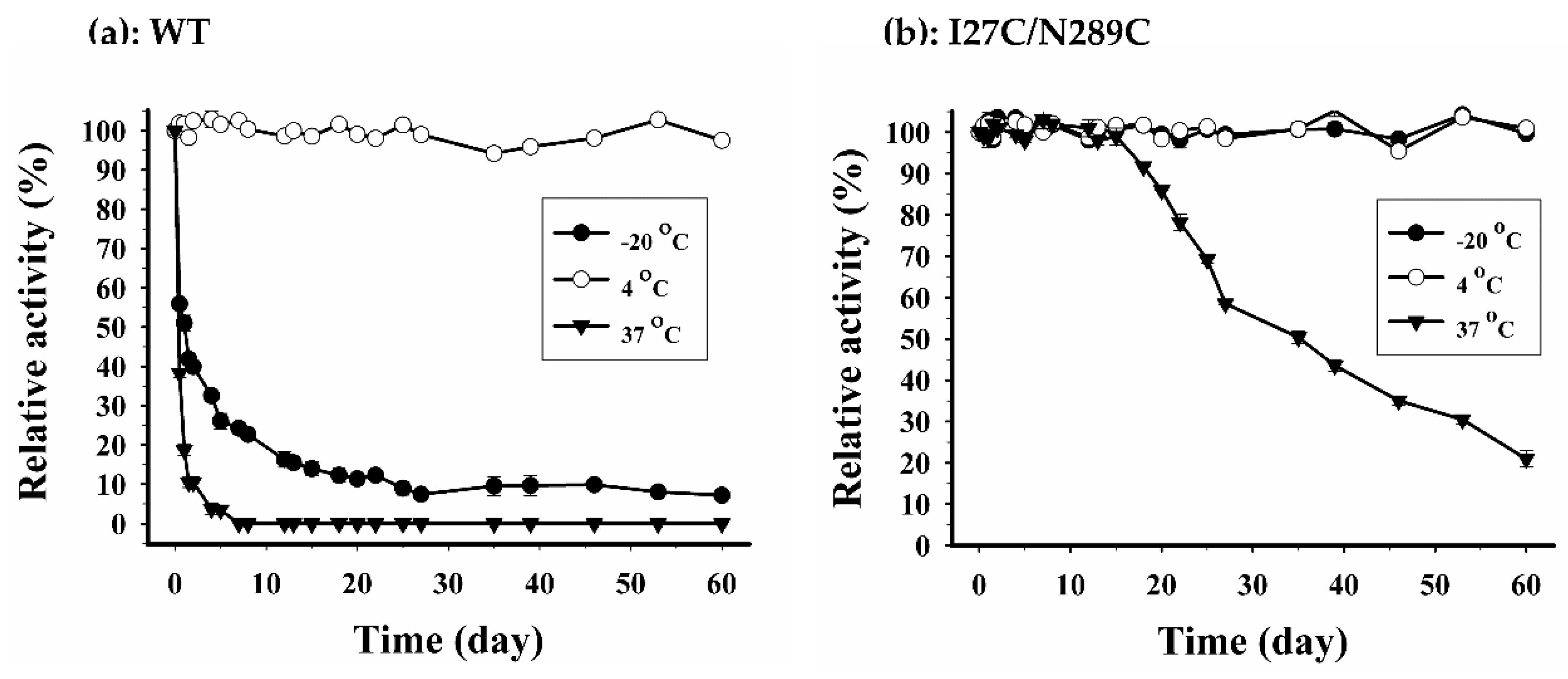
| Validation Index | Model 1 (Based on PDB ID: 4MB8) | Model 2 (Based on PDB ID: 5M98) |
|---|---|---|
| SWISS-MODEL | ||
| GMQE | 0.80 | 0.81 |
| QMEAN | −1.55 | −1.39 |
| Ramachandran plot (PROCHECK) | ||
| Residues in most favoured regions | 88.4% | 90.7% |
| Residues in additional allowed regions | 9.4% | 8.7% |
| Residues in generously allowed regions | 1.1% | 0.5% |
| Residues in disallowed regions | 1.2% | 0.1% |
| Pro-Q | ||
| LG-score | 6.915 | 7.339 |
| MaxSub-score | 0.647 | 0.711 |
| ProSA Z-score | −5.85 | −6.09 |
| Verify3D (% of amino acids with average 3D-1D score ≥ 0.2) | 78.31% | 81.23% |
| Residue Pairs | Number of Disulphide Bridge/ Enzyme Molecule | Inter-Subunit Linkage |
|---|---|---|
| S136C | 2 | A-C and B-D |
| D288C | 2 | A-D and B-C |
| N289C | 2 | A-D and B-C |
| I27C/N289C | 4 | 2(A-B) and 2(C-D) |
| A132C/A225C | 4 | 2(A-C) and 2(B-D) |
| LM-UOX and Variants | Specific Activity (unit/mg) | Km (µM) | kcat (s−1) | kcat/Km (µM−1 s−1) | Yield (mg/1-L Culture) |
|---|---|---|---|---|---|
| WT | 10.45 ± 0.14 | 18.43 ± 0.4 | 29.89 ± 0.3 | 1.62 | 132.1 |
| S136C | 7.88 ± 0.08 | 15.28 ± 0.1 | 22.49 ± 0.1 | 1.47 | 130.0 |
| D288C | 9.38 ± 0.09 | 189.65 ± 0.2 | 65.07 ± 0.3 | 0.34 | 5.8 |
| N289C | 10.38 ± 0.10 | 30.46 ± 0.1 | 34.06 ± 0.1 | 1.12 | 13.2 |
| I27C/N289C | 9.75 ± 0.05 | 35.39 ± 0.1 | 32.58 ± 0.2 | 0.92 | 100.5 |
| A132C/A225C | 15.38 ± 0.12 | 39.19 ± 0.5 | 58.19 ± 0.6 | 1.49 | 40.5 |
| Primers | Description | DNA sequence (5’→3′) |
|---|---|---|
| LM-UOX FP a | for construction of pET20LM-UOX | GGTCTTCCATATGTCCCACTATGTTTCC |
| LM-UOX RP b | CCGCTCGAGCAGTTTGGAATGTGCC | |
| I27C FP | for mutagenesis of I27→C27 | GGCTACGGGAAAAACTGCGTAAAAGTCTTGCAC |
| I27C RP | GTGCAAGACTTTTACGCAGTTTTTCCCGTAGCC | |
| A132C FP | for mutagenesis of A132→C132 | GCATGTGCATTGCTTTATTTACAGTCC |
| A132C RP | GGACTGTAAATAAAGCAATGCACATGC | |
| S136C FP | for mutagenesis of S136→C136 | GCATGCTTTTATTTACTGTCCAGAAGCAACTCGG |
| S136C RP | CGAGTTGCTTCTGGACAGTAAATAAAAGCATG | |
| A225C FP | for mutagenesis of A225→C225 | ATTGAGAAGTTTTGTGGCCCTTACGAGTG |
| A225C RP | CACTCGTAAGGGCCACAAAACTTCTCAAT | |
| D288C FP | for mutagenesis of D288→C288 | GTTCTGCTGCCTCTGTGCAACCCATCTGGCAAC |
| D288C RP | GTTGCCAGATGGGTTGCACAGAGGCAGCAGAAC | |
| N289C FP | for mutagenesis of N289→C289 | CTGCTGCCTCTGGACTGCCCATCTGGCAACATTAC |
| N289C RP | GTAATGTTGCCAGATGGGCAGTCCAGAGGCAGCAG |
© 2019 by the authors. Licensee MDPI, Basel, Switzerland. This article is an open access article distributed under the terms and conditions of the Creative Commons Attribution (CC BY) license (http://creativecommons.org/licenses/by/4.0/).
Share and Cite
Yainoy, S.; Phuadraksa, T.; Wichit, S.; Sompoppokakul, M.; Songtawee, N.; Prachayasittikul, V.; Isarankura-Na-Ayudhya, C. Production and Characterization of Recombinant Wild Type Uricase from Indonesian Coelacanth (L. menadoensis) and Improvement of Its Thermostability by In Silico Rational Design and Disulphide Bridges Engineering. Int. J. Mol. Sci. 2019, 20, 1269. https://doi.org/10.3390/ijms20061269
Yainoy S, Phuadraksa T, Wichit S, Sompoppokakul M, Songtawee N, Prachayasittikul V, Isarankura-Na-Ayudhya C. Production and Characterization of Recombinant Wild Type Uricase from Indonesian Coelacanth (L. menadoensis) and Improvement of Its Thermostability by In Silico Rational Design and Disulphide Bridges Engineering. International Journal of Molecular Sciences. 2019; 20(6):1269. https://doi.org/10.3390/ijms20061269
Chicago/Turabian StyleYainoy, Sakda, Thanawat Phuadraksa, Sineewanlaya Wichit, Maprang Sompoppokakul, Napat Songtawee, Virapong Prachayasittikul, and Chartchalerm Isarankura-Na-Ayudhya. 2019. "Production and Characterization of Recombinant Wild Type Uricase from Indonesian Coelacanth (L. menadoensis) and Improvement of Its Thermostability by In Silico Rational Design and Disulphide Bridges Engineering" International Journal of Molecular Sciences 20, no. 6: 1269. https://doi.org/10.3390/ijms20061269
APA StyleYainoy, S., Phuadraksa, T., Wichit, S., Sompoppokakul, M., Songtawee, N., Prachayasittikul, V., & Isarankura-Na-Ayudhya, C. (2019). Production and Characterization of Recombinant Wild Type Uricase from Indonesian Coelacanth (L. menadoensis) and Improvement of Its Thermostability by In Silico Rational Design and Disulphide Bridges Engineering. International Journal of Molecular Sciences, 20(6), 1269. https://doi.org/10.3390/ijms20061269






